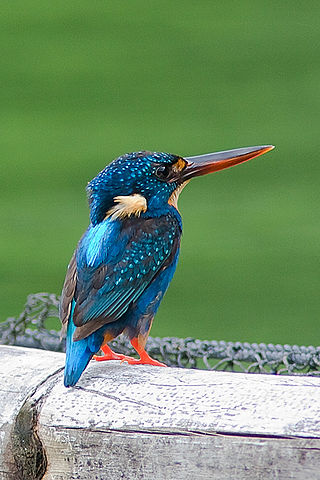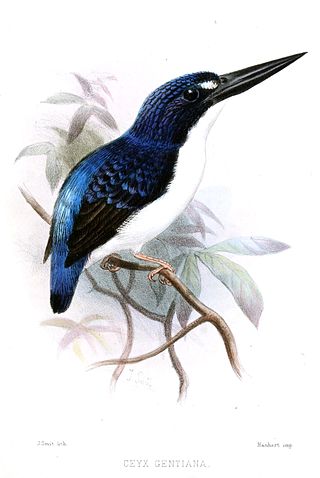
The river kingfishers or pygmy kingfishers, subfamily Alcedininae, are one of the three subfamilies of kingfishers. The river kingfishers are widespread through Africa and east and south Asia as far as Australia, with one species, the common kingfisher also appearing in Europe and northern Asia. This group includes many kingfishers that actually dive for fish. The origin of the subfamily is thought to have been in Asia.

The Indigo-banded kingfisher is a species of bird in the family Alcedinidae. It is endemic to the Philippines, where it is generally uncommon but locally widespread in the northern and central islands.

The oriental dwarf kingfisher, also known as the black-backed kingfisher or three-toed kingfisher, is a pocket-sized bird in the family Alcedinidae. This tropical kingfisher is a partial migrant that is endemic across much of the Indian Subcontinent and Southeast Asia. It resides in lowland forests, typically near streams or ponds, where it feeds upon insects, spiders, worms, crabs, fish, frogs, and lizards. This small bird is easily distinguishable from other birds in its range due to its red bill, yellow-orange underparts, lilac-rufous upperparts, and blue-black back.

The Sulawesi dwarf kingfisher is a species of bird in the family Alcedinidae that is endemic to Sulawesi island, Indonesia. The species has numerous common names such as Celebes forest kingfisher, blue-crowned kingfisher, Celebes dwarf-kingfisher, and Celebes pygmy-kingfisher.

The Philippine dwarf kingfisher is a species of bird in the family Alcedinidae that is endemic to the Philippines found in the islands of Luzon, Polillo Islands, Catanduanes, Basilan, Samar, Leyte and Mindanao. Its natural habitat is tropical moist lowland forests. But it is threatened by habitat loss.

Winchell's kingfisher or the rufous-lored kingfisher, is a species of bird in the family Alcedinidae, the kingfishers. It is endemic to the Philippines, its natural habitat being lowland forests. It is threatened by deforestation, and the International Union for Conservation of Nature (IUCN) has assessed it as a vulnerable species.

Ceyx is an Old World genus of river kingfishers. These kingfishers are found from South East Asia to the Solomon Islands.
Variable dwarf kingfisher is a common name of a group of kingfishers in the genus, Ceyx.

The dimorphic dwarf kingfisher is a species of bird in the family Alcedinidae that is endemic to the central and southern Philippines. Its natural habitat is subtropical or tropical moist lowland forests.

The Sula dwarf kingfisher, is a species of bird in the family Alcedinidae that is endemic to the Sula Islands in Indonesia. Its natural habitat is subtropical or tropical moist lowland forests. It was formerly considered to be a subspecies of the variable dwarf kingfisher.

The Buru dwarf kingfisher, is a species of bird in the family Alcedinidae that is endemic to Buru Island in Indonesia. Its natural habitat is subtropical or tropical moist lowland forests.

The Papuan dwarf kingfisher, is a species of bird in the family Alcedinidae that is endemic to the western Papuan islands, New Guinea, Aru Islands and the D'Entrecasteaux Archipelago. Its natural habitat is subtropical or tropical moist lowland forests.
The Manus dwarf kingfisher, is a species of bird in the family Alcedinidae that is endemic to the Admiralty Islands. Its natural habitat is subtropical or tropical moist lowland forests.
The New Ireland dwarf kingfisher, is a species of bird in the family Alcedinidae that is endemic to New Hanover Island, New Ireland and the Lihir Islands. Its natural habitat is subtropical or tropical moist lowland forests.
The New Britain dwarf kingfisher, is a species of bird in the family Alcedinidae that is endemic to New Britain and Umboi Island. Its natural habitat is subtropical or tropical moist lowland forests.

The North Solomons dwarf kingfisher, is a species of bird in the family Alcedinidae that is endemic to the west and central Solomon Islands. Its natural habitat is subtropical or tropical moist lowland forests.
The New Georgia dwarf kingfisher, is a species of bird in the family Alcedinidae that is endemic to the west central Solomon Islands. Its natural habitat is sub-tropical or tropical moist lowland forests.
The Guadalcanal dwarf kingfisher, is a species of bird in the family Alcedinidae that is endemic to Guadalcanal Island. Its natural habitat is sub-tropical or tropical moist lowland forests.
The Malaita dwarf kingfisher, is a species of bird in the family Alcedinidae that is endemic to Malaita Island. Its natural habitat is subtropical or tropical moist lowland forests.

The Makira dwarf kingfisher is a species of bird in the family Alcedinidae that is endemic to Makira Island. Its natural habitat is subtropical or tropical moist lowland forests.














